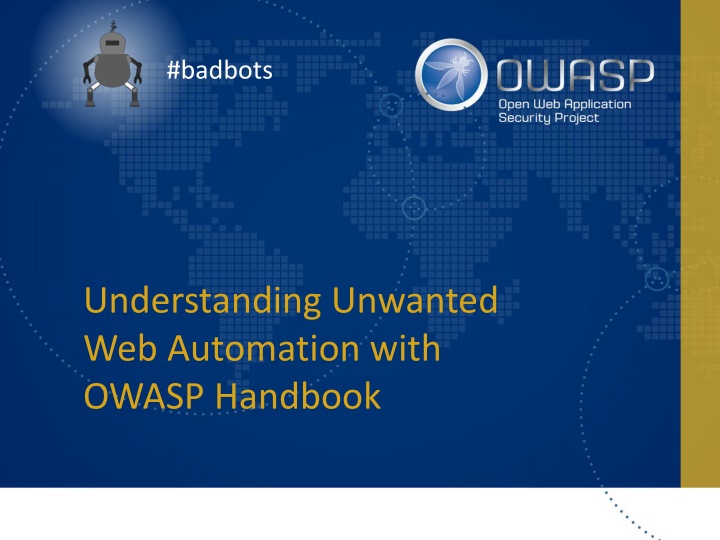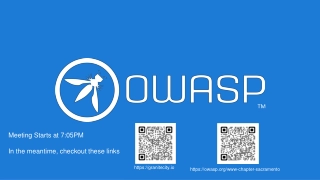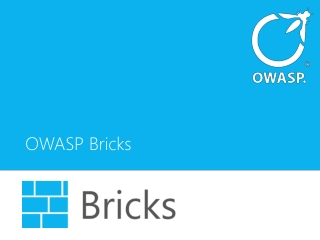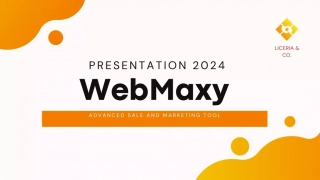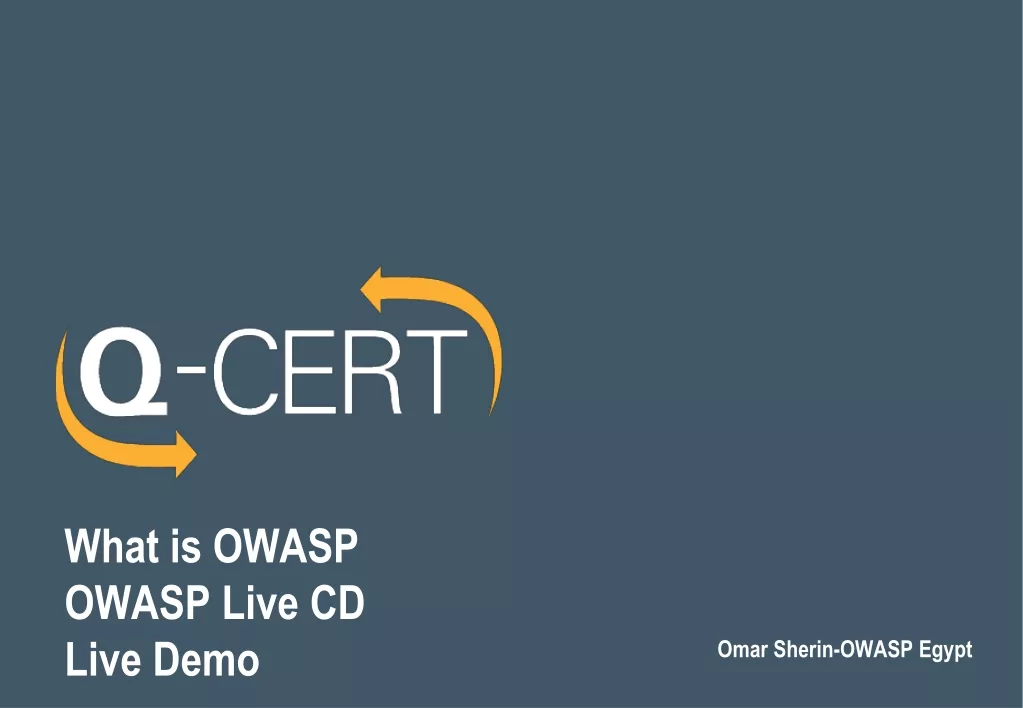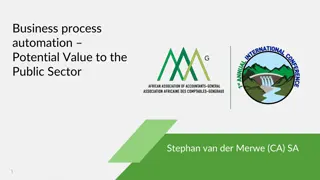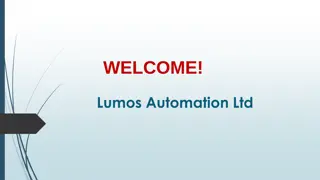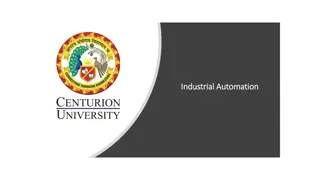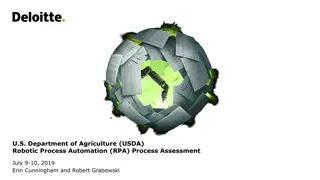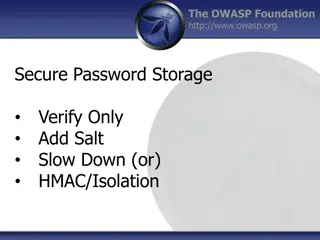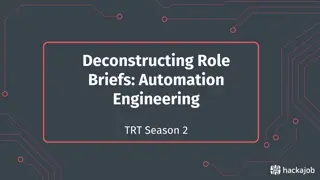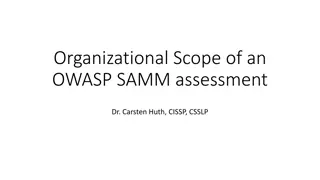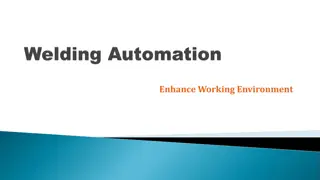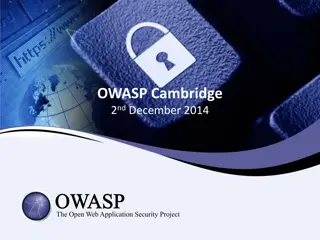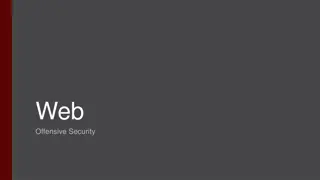Unwanted Web Automation and OWASP Handbook Overview
the issues of automated threats on web applications as outlined by OWASP Handbook, along with countermeasures and a comprehensive ontology of unwanted automation. Learn about the challenges and solutions in addressing bad bots and protecting web assets.
Download Presentation

Please find below an Image/Link to download the presentation.
The content on the website is provided AS IS for your information and personal use only. It may not be sold, licensed, or shared on other websites without obtaining consent from the author.If you encounter any issues during the download, it is possible that the publisher has removed the file from their server.
You are allowed to download the files provided on this website for personal or commercial use, subject to the condition that they are used lawfully. All files are the property of their respective owners.
The content on the website is provided AS IS for your information and personal use only. It may not be sold, licensed, or shared on other websites without obtaining consent from the author.
E N D
Presentation Transcript
#badbots Understanding Unwanted Web Automation with OWASP Handbook
Agenda Why? What? Ontology Use Cases Threats Countermeasures Roadmap
Why? Problem Definition All high and medium vulnerabilities eliminated, OWASP Top 10 covered and the S-SDLC ticking along nicely. You need to buy our DoesItAll product as a service offering for that. Wait! My Ops team is battling against attacks all the time. Operations Vendor Sales Rep Information Security
OWASP Automated Threats to Web Applications WHAT THE PROJECT
Good Bots, Bad Bots Good Bots Search engine crawlers API access Health checks Bad Bots OATs!
To help web applications defend against automated threats https://www.owasp.org/index.php/OWASP_Automated_Threats_to_Web_Applications
Contributors Colin Watson Founder and Co-leader Tin Zaw Co-leader Contributors Jason Chan Mark Hall Andrew van der Stock Roland Weber Vendors
Introducing OATs OWASP Automated Threats Ontology of Unwanted Automation Not Vulnerabilities Not Top 10 or Top 20 OWASP 20 #badbots
OWASP Automated Threats to Web Applications THE ONTOLOGY
Twenty OATs The Complete List Account Aggregation Expediting Account Creation Fingerprinting Ad Fraud Footprinting CAPTCHA Bypass Scalping Carding Scraping Card Cracking Skewing Cashing Out Sniping Credential Cracking Spamming Credential Stuffing Token Cracking Denial of Service Vulnerability Scanning
Whats New in v1.1 Introduction of 14 countermeasure classes Authentication Instrumentation Reputation Etc. Application of generic countermeasures to specific threats More threat specific symptoms
Use Case Scenarios GREAT! HOW DO I USE IT?
Use Case Scenario 1 Defining application development security requirements Security Architect
Use Case Scenario 2 Sharing intelligence within a sector with peers CISO
Use Case Scenario 3 Exchanging threat data between CERTs Security Analyst
Use Case Scenario 4 Enhancing application penetration test findings Penetration Test Lead
Use Case Scenario 5 Specifying service acquisition needs Purchasing Manager
Use Case Scenario 6 Characterizing vendor services Vendor Sales Rep
OWASP Automated Threats LET S WALK THROUGH SOME EXAMPLES
Example 1: Account Takeover Business problem An attacker takes over an account of a legitimate user Technical threats OAT-007 Credential Cracking OAT-008 Credential Stuffing
OAT-007 Credential Cracking Identify valid login credentials by trying different values for usernames and/or passwords. AKA Brute-force attacks against sign-in; Brute forcing log-in credentials; Brute-force password cracking; Cracking login credentials; Password Brute-Forcing; Password cracking; Reverse Brute Force attack; Username cracking; Username enumeration
OAT-008 Credential Stuffing Mass log in attempts used to verify the validity of stolen username/password pairs. AKA Account checker attack; Account checking; Account takeover; Account takeover attack; Login Stuffing; Password list attack; Password re-use; Stolen credentials; Use of stolen credentials
Example 2: Credit Card Abuse Business problem My credit card chargeback rate and transaction costs are high Technical threats OAT-001 Carding OAT-010 Card Cracking OAT-012 Cashing Out
OAT-001 Carding Multiple payment authorisation attempts used to verify the validity of bulk stolen payment card data. AKA Card stuffing; Credit card stuffing; Card verification
OAT-010 Card Cracking Identify missing start/expiry dates and security codes for stolen payment card data by trying different values. AKA Brute forcing credit card information; Card brute forcing; Credit card cracking
OAT-012 Cashing Out Buy goods or obtain cash utilising validated stolen payment card or other user account data. AKA Money laundering; Online credit card fraud; Online payment card fraud; Refund fraud; Stolen identity refund fraud (SIRF)
Example 3: E-Commerce Stats Skewed Business problem My e-commerce stats must be skewed click-to-purchase ratio is way off compared to historic data Technical threats OAT-003 Ad Fraud OAT-016 Skewing
OAT-003 Ad Fraud False clicks and fraudulent display of web-placed advertisements. AKA Advert fraud; Adware traffic; Click bot; Click fraud; Hit fraud; Impression fraud; Pay per click advertising abuse; Phoney ad traffic
OAT-016 Skewing Repeated link clicks, page requests or form submissions intended to alter some metric. AKA Biasing KPIs; Boosting friends, visitors and likes; Click fraud; Election fraud; Hit count fraud; Market distortion; Metric and statistic skewing; Page impression fraud; Poll fraud; Poll skewing; Poll/voting subversion; Rating/review skewing; SEO; Stock manipulation; Survey skewing
Example 4: Stress on Infrastructure Business problem Infrastructure experiences spikes in CPU, memory and network load, occasionally crashing JVMs Technical threats OAT-015 Denial of Service OAT-014 Vulnerability Scanning
OAT-015 Denial of Service Target resources of the application and database servers, or individual user accounts, to achieve denial of service (DoS). AKA Account lockout; App layer DDoS; Asymmetric resource consumption (amplification); Business logic DDoS; Cash overflow; Forced deadlock; Hash DoS; Inefficient code; Indexer DoS; Large files DoS; Resource depletion, locking or exhaustion; Sustained client engagement
OAT-014 Vulnerability Scanning Crawl and fuzz application to identify weaknesses and possible vulnerabilities. AKA Active/Passive scanning; Application-specific vulnerability discovery; Identifying vulnerable content management systems (CMS) and CMS components; Known vulnerability scanning; Malicious crawling; Vulnerability reconnaissance
Example 5: Goods in Wrong Hands Business problem I can t sell my goods to the customers I intend to sell to Technical threats OAT-005 Scalping OAT-013 Sniping
OAT-005 Scalping Obtain limited-availability and/or preferred goods/services by unfair methods. AKA Bulk purchase; Purchase automaton; Purchase bot; Restaurant table/hotel room reservation speed-booking; Queue jumping; Sale stampede; Ticket resale; Ticket scalping; Ticket touting
OAT-013 Sniping Last minute bid or offer for goods or services. AKA Auction sniping; Bid sniper; Front-running; Last look; Last minute bet; Timing attack
New in Version 1.1 COUNTERMEASURES
14 Countermeasure Classes Value Authentication Requirements Rate Testing Monitoring Capacity Instrumentation Obfuscation Contract Fingerprinting Response Reputation Sharing
Countermeasures in SDLC Phases Builder Ability (willing and able) to make changes to the source code Defender Must work around the existing system
Countermeasures Types Prevent Not allow the threat to have a negative effect Usually for Builders (but also for business, e.g., contracts) Detect Identify the threat is in action Prevent threat from reaching the system or limit the negative effect Recover Focuses on limiting loss after threat has reached the system
Countermeasure: Fingerprinting Consider identifying and restricting automated usage by automation identification techniques. Utilize user agent string, and/or HTTP request format (e.g. header ordering), and/or HTTP header anomalies (e.g. HTTP protocol, header inconsistencies), and/or device fingerprint content to determine whether a user is likely to be a human or not.
Countermeasure: Fingerprinting SDLC phases Builder, Defender Countermeasure type Prevent, Detect, Recover Applicability All OATs, including Fingerprinting
Countermeasure: Rate Set upper and/or lower and/or trend thresholds, and limit number and/or rate of usage per user, per group of users, per IP address/range, per device id/fingerprint, etc. Also limitation of value per event/transaction. Also includes use of queuing systems, user-prioritization functionality and randomization of asset allocation.
Countermeasure: Rate SDLC phases Builder, Defender Countermeasure type Prevent, Detect, Recover Applicability All OATs except Ad Fraud and Fingerprinting
Countermeasure: Capacity Build adequate capacity so that any permitted and possible unwanted automated usage does not affect normal usage/performance.
Countermeasure: Capacity SDLC phases Builder, Defender Countermeasure type Prevent, Detect, Recover Applicability Denial of Service
Countermeasure: Contract Require users not to undertake automated attacks against the application through terms & conditions, contracts and guidance. Understand contractual restrictions imposed by other parties on the application (e.g. service level agreements, financial credit).
Countermeasure: Contract SDLC phases Builder, Defender Countermeasure type Prevent, Detect, Recover Applicability Most OATs except Fingerprinting, Footprinting and Cashing out
Countermeasure: Sharing Share information about automated attacks with others in same sector, with trade organizations, OWASP community and with national CERTs.
Countermeasure: Sharing SDLC phases Builder, Defender Countermeasure type Prevent, Detect, Recover Applicability All OATs!
